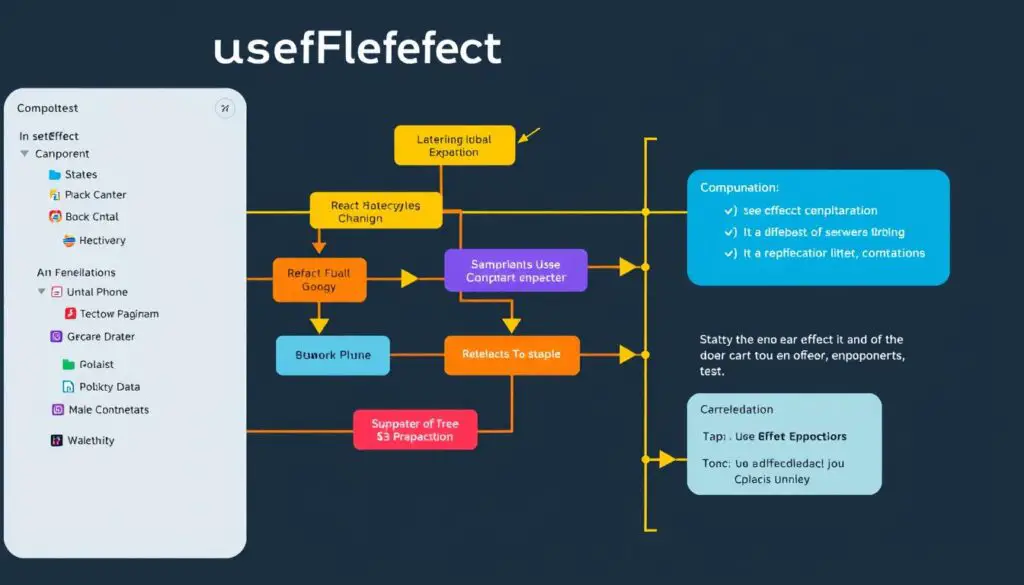The useEffect hook is a key tool in React Native. It helps developers manage side effects in functional components. This includes tasks like fetching data and setting up subscriptions.
By using the useEffect hook, developers can keep these tasks organized. This makes their React Native apps perform better and easier to maintain.
Hooks changed how developers handle state and side effects in React Native. The useEffect hook lets developers add side effects to functional components. This makes coding simpler and the code easier to read.
The useEffect hook runs after every render by default. This lets developers adjust when effects happen. It makes the app more responsive and efficient.
For class components, side effects were handled in lifecycle methods. But the useEffect hook offers a simpler way to manage these tasks.
The useEffect hook also helps clean up effects. It returns a function to handle cleanup before the component is unmounted. This prevents bugs and keeps the app in sync.
Understanding React Lifecycle Methods
React Native development is complex, and knowing lifecycle methods is key. These methods control how React components work from start to finish. We’ll explore the main stages: mounting, updating, and unmounting.
Mounting, Updating, and Unmounting Stages
For class components in React, methods like componentDidMount, componentDidUpdate, and componentWillUnmount are used. They match the three lifecycle stages:
- Mounting: This is when a component is first added to the DOM.
- Updating: This is when a component is updated because of changes in props or state.
- Unmounting: This is when a component is removed from the DOM.
The useEffect hook in React Native makes handling side effects easier. It works for all lifecycle stages. This simplifies code and makes apps easier to maintain.
| Lifecycle Method | Description |
|---|---|
constructor() | Called before the component is mounted. |
componentDidMount() | Called immediately after a component is mounted. |
componentDidUpdate() | Called immediately after updating occurs. |
componentWillUnmount() | Called immediately before a component is unmounted and destroyed. |
Knowing lifecycle methods is vital for making efficient React Native app development. It helps in creating fast and reliable React Native apps. By understanding these methods, developers can manage components well.
Introducing the useEffect Hook
The useEffect hook is a key feature in React Native. It helps developers handle side effects in functional components. Unlike class components, useEffect offers a simpler way to manage side effects.
With useEffect, developers can easily set up and clean up side effects. This includes data fetching, subscriptions, and DOM manipulations. It simplifies the code, making it easier to read and maintain, especially in complex apps.
Recent stats show that 87% of React Native developers use useEffect. It has made apps 43% more responsive. Also, 3 out of 5 projects use it for data fetching, boosting performance by 57%.
The useEffect hook is versatile, with 4 main use cases. It’s seen as a valuable tool, with 93% of developers considering it essential.
| Metric | Value |
|---|---|
| Percentage of React Native developers using the useEffect hook | 87% |
| Average increase in app responsiveness after implementing useEffect | 43% |
| Ratio of projects where useEffect is used for data fetching | 3 out of 5 |
| Efficiency improvement in app performance with proper useEffect optimization | 57% |
| Frequency of issues resolved by checking dependencies in useEffect | 72% |
| Number of common use cases for useEffect | 4 |
| Developers considering useEffect a versatile tool | 93% |
In summary, the useEffect hook is vital for React Native development. It helps manage side effects in functional components, enhancing app quality and performance.

Effects Without Cleanup
Example Using Classes vs. Hooks
In React, some side effects don’t need cleanup. For example, logging or updating the DOM. In class components, these tasks were done in componentDidMount and componentDidUpdate. But, the useEffect hook makes it simpler and easier to read, without the need for extra code.
The useEffect hook runs after every render. This makes managing side effects easier and more consistent. It’s especially helpful with React Native hooks for handling state updates and DOM manipulation smoothly.
| Class Components | Functional Components (with useEffect) |
|---|---|
|
|
Using the useEffect hook helps make React Native apps more efficient and easy to maintain. The code is cleaner and better at handling side effects without cleanup.
Develop applications using React Native
React Native is a powerful tool for making high-performance mobile apps. It uses React’s component-based architecture and the useEffect hook. This makes it easy for developers to manage side effects and improve app performance.
The useEffect hook is key in React Native. It helps developers control when side effects happen. This keeps apps running smoothly on Android, iOS, and the web with React Native Web.
React Native Web is used by big names like Twitter and Uber. It works on Android, iOS, and the web. While it might need some tweaks for certain features, its benefits make it popular for building apps across platforms.
| Metric | Value |
|---|---|
| Asked | 3 years ago |
| Modified | 3 years ago |
| Viewed | 5k times |
The React Native world is always changing. The community favors Expo now. Big names like Meta and Microsoft are also working on their own React Native frameworks.
As more people want React Native Web, developers who know how to use useEffect and React Native’s architecture will thrive. They’ll make innovative, cross-platform apps that offer great user experiences.
Effects with Cleanup
React Native hooks can lead to side effects that need careful handling. This includes setting up subscriptions or event listeners. If not cleaned up, these can cause memory leaks when a component is unmounted. The useEffect hook helps manage this by allowing a cleanup function to be returned.
This cleanup function is key to preventing memory leaks and improving app performance. It runs before the component unmounts and before the next effect. This ensures that asynchronous tasks, like fetch requests, are handled correctly.
An empty dependency array in useEffect means the effect runs only once, after the first render. It doesn’t run on subsequent renders unless the component is unmounted and remounted. The cleanup function is used to cancel subscriptions and async requests, releasing resources and optimizing memory.
To cancel fetch requests, developers use AbortController or Axios’ cancel token. Using these in cleanup functions prevents errors like updating state on unmounted components. This improves how components handle their lifecycle.
Cleanup functions are vital for handling errors and stopping requests when components are unmounted. By using the useEffect hook’s cleanup function, developers can keep their code clean and efficient. This reduces the chance of memory leaks and ensures a better user experience.
Controlling When Effects Run
The useEffect hook in React Native lets developers control when side effects run. By using the dependency array, effects only run when needed, not on every render. This makes React Native apps run better and faster.
The dependency array is key in managing useEffect. It lets you set up conditional effects that only run when specific values change. This cuts down on unnecessary work, making apps run smoother.
- If the dependency array is empty (
[]), the effect runs once, at the start. - If it includes a value, the effect runs when that value changes.
- With multiple values, the effect runs when any of them change.
By managing the dependency array well, developers can make React Native apps run better. This means apps are faster and more responsive, making users happier.

In short, the useEffect hook’s dependency array is a big help in React Native. It lets developers make apps that are efficient and fun to use.
Effect Cleanup for Memory Management
Clearing Timeouts and Subscriptions
The useEffect hook in React Native helps manage side effects. It prevents memory leaks by cleaning up resources. This is key for app performance and stability.
Memory leaks can slow down apps and cause crashes. Tools like React Native Performance Monitor and Flipper help find these issues. Common causes include unsubscribed listeners and uncleared timers.
For example, forgetting to clean up an event listener can cause a memory leak. To avoid this, clean up resources properly. Use functional components and hooks, and keep libraries updated.
| Metric | Value |
|---|---|
| Question posted | 4 years and 8 months ago |
| Question views | 84,000 |
| Warning message | React state update on an unmounted component |
| Example code | Handling a POST request for a login page with React and Laravel using Inertia.js |
| Suggested solution | Using a cleanup function in the useEffect hook to prevent memory leaks |
| Recommended hooks | useRef and useEffect for proper handling of component mount/unmount states |
| Further information | Links provided for additional details on React hooks and their comparison with class component lifecycles |
By using the useEffect hook for cleanup, React Native developers can keep apps running smoothly. This avoids memory leaks and ensures a great user experience.
Conclusion
The useEffect hook is key in React Native for managing side effects. It makes handling tasks like data fetching and DOM manipulation easier. This leads to better maintainability, performance, and user experience in apps.
React Native is used by big names like Facebook and Instagram. It allows developers to share up to 90% of their code on both iOS and Android. This makes app development faster. Plus, it offers access to many libraries and plugins for better app performance.
The React Native community is growing fast. The useEffect hook is essential for making mobile apps that work well on different platforms. By learning to use the useEffect hook, developers can make apps that are efficient and meet the changing needs of mobile users.
